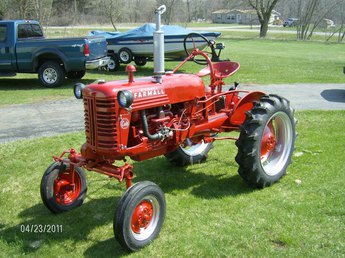The Farmall Cub
Farmall Cub Tractor Parts

A Brief History
The Farmall Cub is the smallest tractor in the International Harvester line, capable of pulling one 12-inch
bottom plow. Production began in 1947 and continued relatively unchanged until 1964. Variations of the tractor
(International Cub Lo-Boys) were continued for some time after that. The Cub was the only Farmall built with an
L-head engine.
Farmall Cubs built in different years can be found with McCormick-Deering, Farmall, and International Harvester
decals, depending upon the configuration of the parent company International Harvester in the year of production.
For the purpose of this article, we will refer to the tractor as simply a "Farmall Cub".
This little tractor was aimed at the needs of the small-acreage farmer - farms of 40 crop acres or less and
truck gardens, or for larger farms that needed an extra tractor. Seven or eight implements were initially designed
for it: Plow, Disc, Backblade, Sickle-Bar Mower, Belly-Mower, and a one-armed front-end loader for starters. Like
the Farmall Model A, the Cub was off-set to the left with the driver and steering wheel on the right. This concept
was called "CultiVision" in reference to the ability of the driver to have a perfect view of a belly-mounted
cultivator. In 1947, the Farmall Cub sold for around $545.00 - attachments and implements were extra.
The Farmall Cub was easily one of the most popular small chore tractors made in history. This is shown by the sheer
numbers of Cubs that were built. People would not stop buying them! With a production run lasting almost 20 years,
over 200,000 of them were built between 1947 and 1964.
The Farmall Cub Today
Today the Farmall Cub is still extremely popular - for many of the same reasons it was popular 50 years ago.
One of the advantages of this popularity is: if you own one, you enjoy a ready supply of new after-market (replacement)
parts.
One of the most popular uses of this tractor today is for mowing large lawns or golf courses with a belly mower
attached. New after-factory belly mowers are available from Woods brand equipment dealers. There are also
3-point hitch kits available for these tractors which makes it possible to use many of todays popular 3-point implements.
You do need to consider the horsepower of the tractor before using a modern implement and make sure that it is
rated for the small size of the Cub.
Many of these tractors are also still in use by gardeners with a large vegetable patch. The Cultivision setup
simply can't be beat for cultivating rows of tender young vegetables.
You'll find quite a few Farmall Cubs restored and parade-ready. You can always find at least one at an Antique
Tractor Show with it's proud owner standing by. They are not rare machines by any means. But due to their continued
popularity they can command a pretty high purchase price. Be prepared to pay anywhere from $1000.00 to $3500.00
for a running tractor, depending upon condition and available implements.
The Specs
Air Cleaner: Donaldson, oil bath.
Battery: Auto-Lite (Special)
Brakes: Two; operated by foot pedal individually or locked together.
Carburetor: IHC, 3/4 inch
Clutch: Rockford or Atwood, single plate, dry disc, spring loaded.
Generator: Delco-Remy (Special)
Governor: IHC, centrifugal, variable speed.
Ignition: IHC, high tension magneto with automatic impulse coupling.
Oil Filter: Purolator, replaceable element.
Radiator: Modine core, fin and flat tube.
Radiator Cover: None
Spark Plugs: Champion 15-A, AC-85S com., Auto-Lite BT8 or Edison Z147, 18 mm.
Starter: Delco-Remy (Special)
Engine: IHC, 2-5/8 x 2-3/4, 1,600 rpm, 4-cylinders, vertical, L-head, cast en bloc; no removable sleeves,
piston displacement 59.5 cu. in.
Pulley: 9x4-1/2, 1,322 rpm and 3,114 fpm at normal engine speed (special)
Speed: MPH forward 2, 3, 6-1/8 and 2-1/4 reverse, on 7-24 tires.
Nebraska Tractor Test Results
TEST NO. 386
International Harvester Co., Chicago, Illinois
DATE TESTED: September 29 to October 9, 1947
No repairs or adjustments were noted for the Farmall Cub during 68 hours of engine operating time required
for this test. Equipped with three forward speeds of 2.14, 3.12, and 6.4 mph, the Cub used second gear for Test
H. Under a rated load of 6.75 drawbar horsepower, it pulled an 837 pound load of 3.02 mph with a slippage of 5.69%,
yielding a fuel economy of 8.6 horsepower hours per gallon gasoline. A maximum low-gear pull of 1,596 pounds was
recorded in Test G - this test also indicates a speed of 1.96 mph and slippage of 10.98%. At an operating maximum
load of 9.23 belt horsepower, the Cub delivered a 10.94 horsepower hours per gallon of gasoline, compared to a
virtually identical figure of 10.27 at the Test D rated load of 8.32 belt horsepower. This tractor was equipped
with 6-24 rear and 4.00-12 front tires - without additional ballast, it weighed in at 1,477 pounds. Standard equipment
included a McCormick-Deering four-cylinder, L-head engine rated at 1600 rpm and carrying a 2-5/8 x 2-3/4 inch bore
and stroke. Also featured on this model was an IHC J-4 magneto and an IHC carburetor.
Serial Numbers
| The serial number name plate is located on the right side of the steering gear housing. |
| Serial Numbers (From 1947 to 1964) |
| Year |
Starting Serial Number |
| 1947 |
501 |
| 1948 |
11348 |
| 1949 |
57831 |
| 1950 |
99536 |
| 1951 |
121454 |
| 1952 |
144455 |
| 1953 |
162284 |
| 1954 |
179412 |
| 1955 |
186441 |
| 1956 |
193658 |
| 1957 |
198231 |
| 1958 |
204389 |
| 1959 |
211441 |
| 1960 |
214974 |
| 1961 |
217382 |
| 1962 |
220038 |
| 1963 |
221383 |
| 1964 |
223453 |
|


